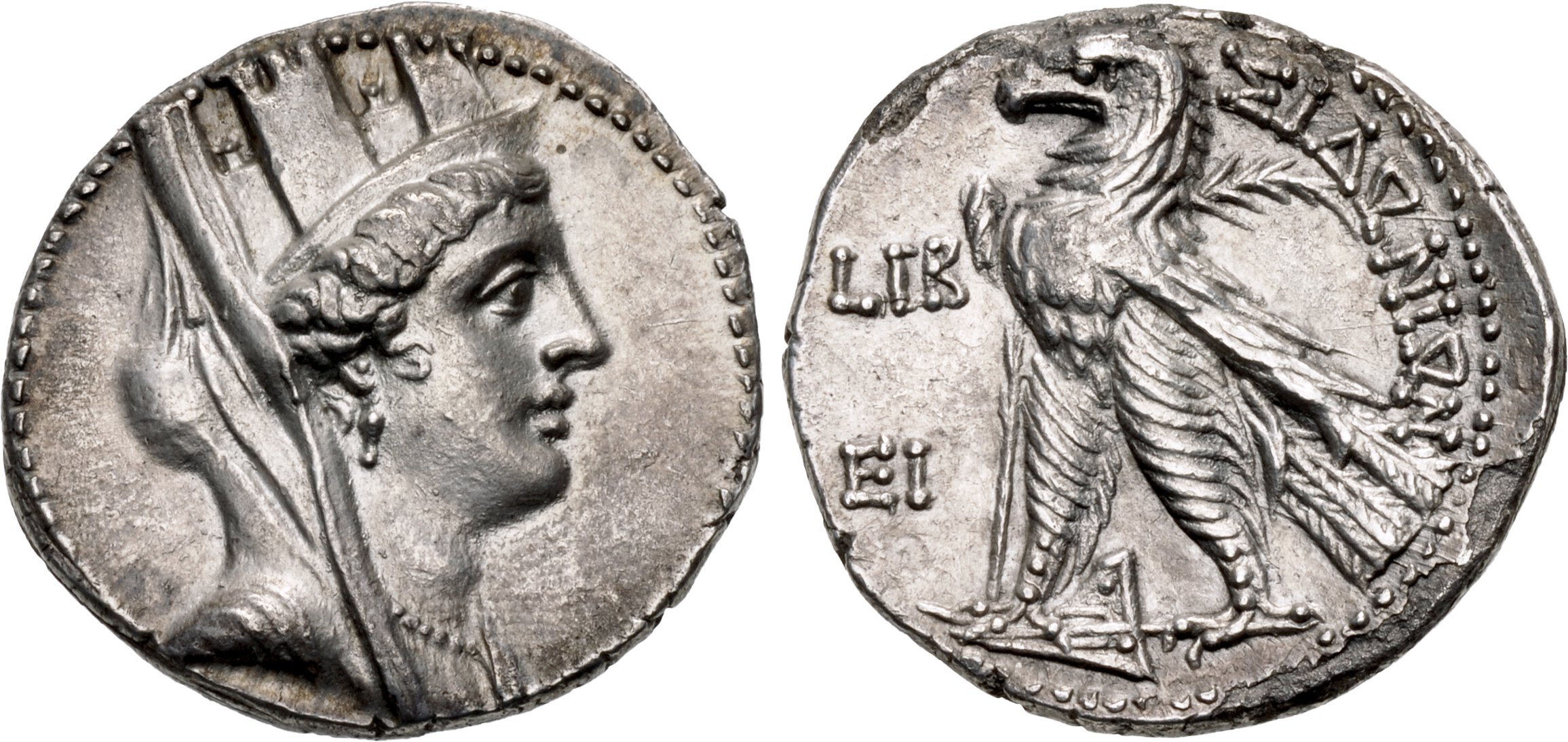Sidon, silver, tetradrachms (107/6-54/3 BCE)
From SILVER
107 BCE - 53 BCE Silver 5,852 kg
Description
| ObverseInscription or printing placed on the obverse.: | Veiled, draped, and turreted bust of Tyche right, wearing single-pendant earring and pearl necklace |
| ReverseInscription or printing placed on the reverse.: | ΣIΔΩNIΩN to right (Greek).Eagle standing left on ram of galley left, palm frond in background, to left, L IB (date) above EI |
Mint and issuing power
| MintIdentifies the place of manufacture or issue of a numismatic object.: | Sidon | Ancient regionAncient region.: | Phoenicia | Modern countryModern country: Lebanon | AuthorityIdentifies the issuing power. The authority can be "pretended" when the name or the portrait of X is on the coin but he/she was not the issuing power. It can also be "uncertain" when there is no mention of X on the coin but he/she was the issuing power according to the historical sources: |
Chronology
| FromIdentifies the initial date in a range assigned in a numismatic context. | 107 BCE | toIdentifies the final date in a range assigned in a numismatic context.. | 53 BCE | PeriodTime period of the numismatic object.: Hellenistic 323-30 BC |
Physical description
| MetalThe physical material (usually metal) from which an object is made.: | Silver |
Median weightMedian of the weights of numismatic objects (in grams). in grams | 13.90 | DenominationTerm indicating the value of a numismatic object. Examples: tetradrachm, chalkous, denarius.: | tetradrachm |
StandardStandard.: | Attic |
Image

S271 Sidon.jpg [1]
References
| Die study referencePublication of the study: | Callataÿ 20021Callataÿ 2002, p. 80. | ||
| Coin series referenceReference to coin series study: | Sear II2Sear II, n° 5950-5952, HGC 103HGC 10, n° 275 | ||
| Coin series web referenceCoin series web references: | |||
Obverse dies distribution
no distribution is available
Reverse dies distribution
no distribution is available
Quantification
| Number of obversesNumber of obverse dies. ᵖ (o) | 14 | Number of singletons (o1)The number of singleton coins. ᵖ | |
| Number of reverse diesNumber of reverse dies. (r) | Number of coinsNumber of coins. (n) | 31 | |
| Coins per obverse dieNumber of coins per obverse die. (n/o) | 2.21 | Coins per reverse dieNumber of coins per reverse die. (n/r) | |
| Reverse per obverse ratioRatio of obverse dies divided by reverse dies. (r/o) | Percentage of singletons (o1)number of coins (n) divided by the number of singletons (o1) ᵖ | % | |
| Original number of dies (O) (Carter 1983 formula)The estimation of the number of coins according to Carter 1983 ᵖ | 21.05 | Coins struck if 20,000 as average productivity per dieCoins made if the average productivity for obverses (according to Carter) is 20,000. ᵖ | 421,000 |
| Original number of dies (O) (Esty 2011 formula)The estimation of the number of coins according to the singleton formula in Esty 2011 ᵖ (O) | 25.53 | Survival rate if 20,000 as average productivity per dieSurvival rate if average productivity is 20,000. ᵖ | 0.00007 |
| Coverage (o = % of O) (Esty 1984 formula)Esty 1984 - coverage (% of O) ᵖ (o = % of O) | % | Die productivity if survival rate 1/2,000Average productivity if survival rate is 1/2,000. ᵖ | 2,945.37 |
| Weight of silver (in kg) if 20,000 coins per die (O = Carter formula)Carter 1983 * Median weight * 20000 (*10 if gold or electrum) ᵖ | 5,852 kg <br /> 5,852 kg | Die productivity if survival rate 1/5,000Average productivity if survival rate is 1/5,000. ᵖ | 7,363.42 |
Remarks
Most likely one single workstation